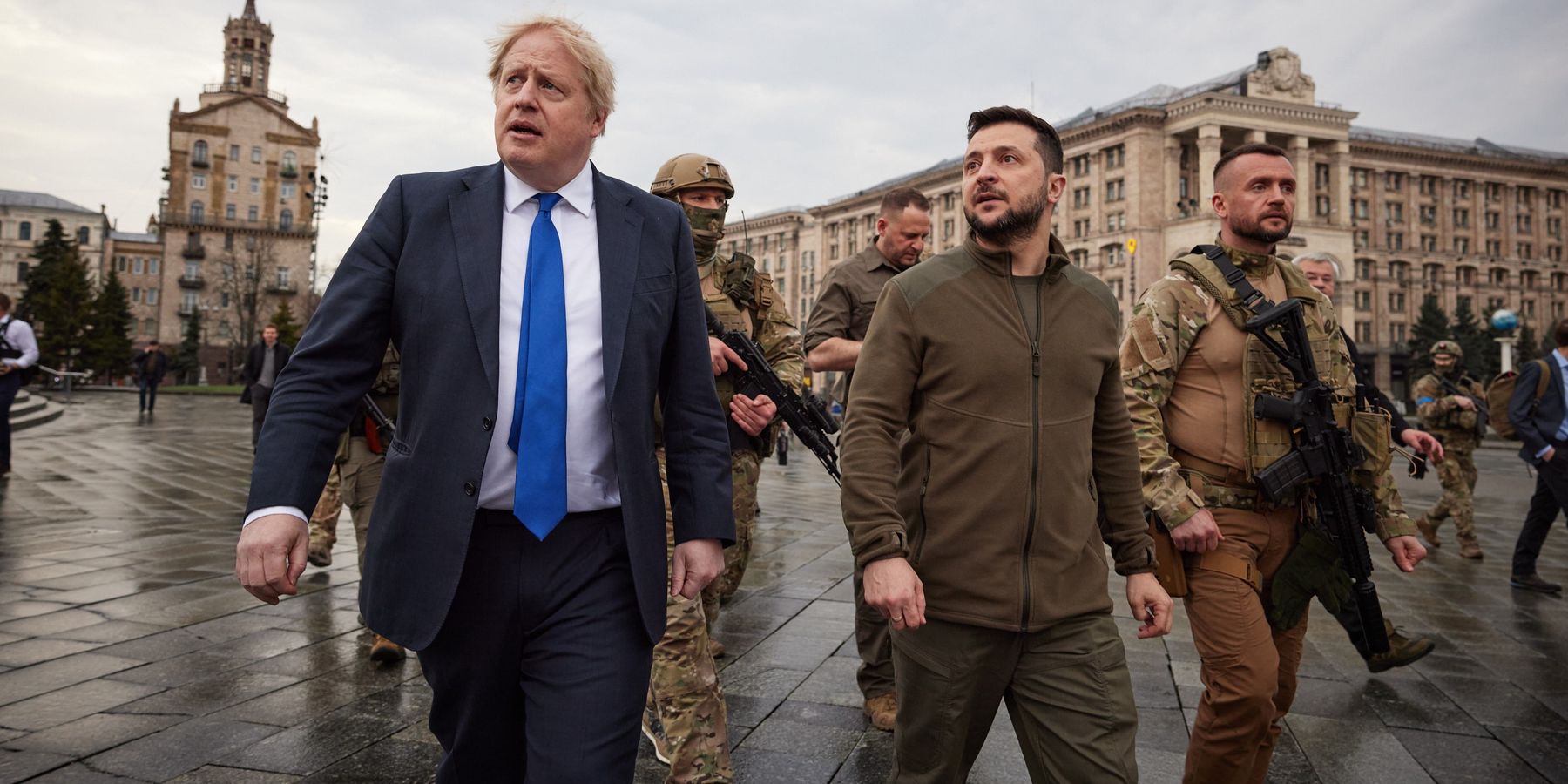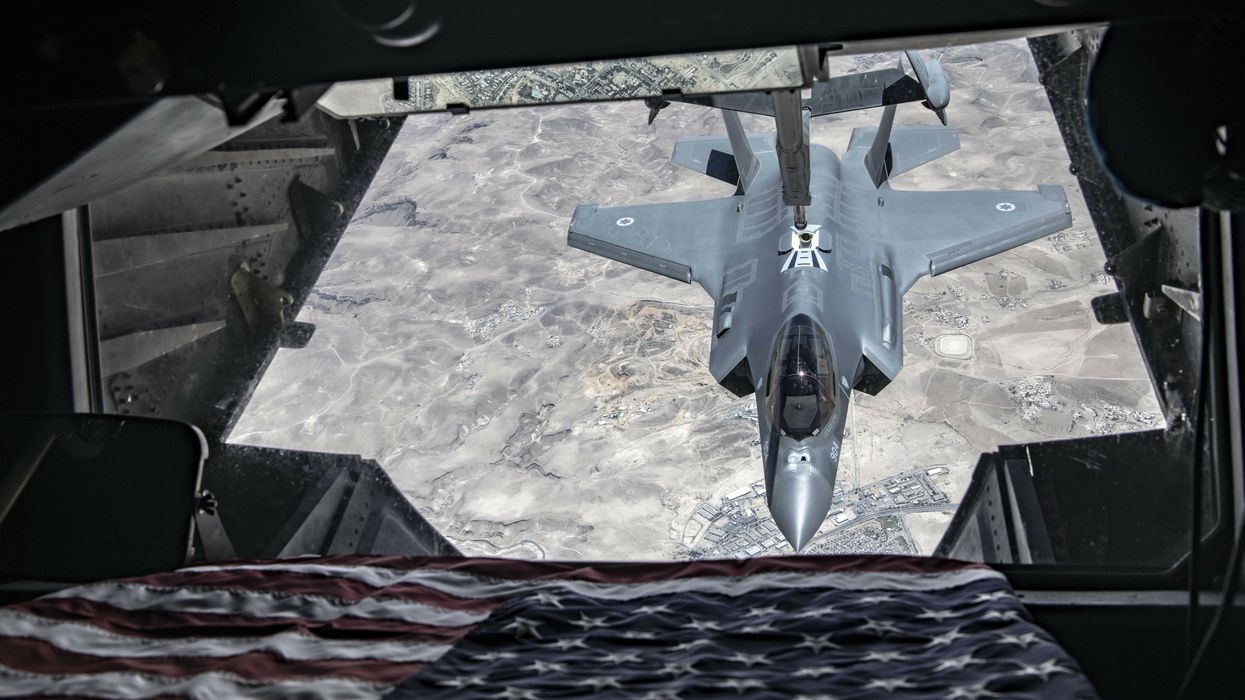It’s becoming increasingly difficult to deny the war in Ukraine could have been ended mere months into the Russian invasion — and that the U.S. and U.K. governments worked to prevent this from happening.
The latest piece of corroboration comes courtesy David Arakhamia, the parliamentary leader of Zelensky’s “Servant of the People” party who led the Ukrainian delegation in peace talks with Moscow. Arakhamia told journalist Natalia Moseichuk in a recent televised interview that “Russia's goal was to push us to take neutrality,” meaning to commit to not joining NATO, and that “they were ready to end the war if we accept neutrality.”
There were several reasons the negotiations ultimately collapsed, he said, including the need to change the Ukrainian constitution (which had been amended in February 2019 to enshrine the country’s NATO aspirations), and the fact that Johnson had come to Kyiv to inform Ukrainian officials the West wouldn’t sign any agreement with Moscow, instead urging: “let’s just fight.”
Arakhamia also said that Kyiv’s lack of trust in the Russian side to fulfill its end of the bargain meant that the peace deal “could only be done if there were security guarantees” — suggesting, obliquely, that negotiations could have borne fruit had they received the backing and involvement of NATO states. Western governments’ provision of security guarantees for Ukraine have long been part of the discussion for how to ensure the sustainability of a post-war peace deal, and in fact, Arakhmia himself disclosed in the same interview that “the Western allies advised us not to agree to ephemeral security guarantees.”
The interview corroborates claims first reported in May 2022 by the broadly Western-aligned Ukrainska Pravda outlet — which reported that Boris Johnson told Ukrainian President Volodymyr Zelensky the West wouldn’t support any peace deal regardless of what Ukraine wanted, and they preferred to keep taking the fight to Russian President Vladimir Putin, who was less powerful than they had thought.
Johnson had himself confirmed, albeit not in so many words, in a phone call to French President Emmanuel Macron that he had urged Zelensky against peace.
All of it lends further weight to multiple accounts over the course of the past 21 months that have claimed Ukraine and Russia were on the brink of peace, but were blocked by NATO states eager for a prolonged war that would weaken Russia and possibly destabilize it.
Former U.S. national security official Fiona Hill reported the two sides had reached a tentative peace deal the same month of Johnson’s surprise visit to Kyiv, while former German Chancellor Gerhard Schroeder, former Israeli Prime Minister Naftali Bennett, and several Turkish officials — all of whom were involved at various times in the talks — have said that NATO officials stopped or undermined negotiations.
Multiple U.S. reports documented a divide in NATO, with the United States and U.K. reportedly heading a faction of states who preferred a longer war than a sooner peace. Historian Niall Ferguson reported overhearing an unnamed U.S. official say in March 2022 that “the only end game now is the end of Putin regime [sic].”
What’s particularly notable is how dramatically these disclosures contrast with the overwhelming thrust of two years’ worth of mainstream discourse on, and analysis of, this war. Until recently, both NATO officials and commentators across the political spectrum insisted that negotiations with Moscow were impossible and that the war could only be ended by pursuing victory on the battlefield, usually by pursuing Kyiv’s maximalist aims of reconquering all of the territory it had lost since 2014. (According to reports, the tentative agreement reached last April would have seen Ukraine exchange neutrality for a Russian withdrawal to its pre-February 2022 borders).
Voices who called for a diplomatic resolution were ignored or viciously smeared, as was anyone who said that Ukraine’s possible entry into NATO was at the heart of the conflict, and that adopting neutrality could help end the war. There is now a mountain of evidence backing both of these claims. In fact, Arakhamia’s interview further drove home the point about NATO membership.
“They actually hoped until nearly the last moment that they could press us into signing this agreement, adopting neutrality,” he said in the interview. “That was essentially the main point. Everything else was cosmetic and political embellishments about ‘denazification,’ the Russian-speaking population, blah blah blah.”
There are several key takeaways here. One is that Americans, and indeed all Western publics, should be far more skeptical in future of claims from officials and commentators that diplomatic solutions to conflicts and negotiations with adversarial governments are impossible or ineffective, and that military solutions are the only answer. Indeed, we’ve seen virtually the same arguments deployed against peace talks between Israel and Hamas — a conflict that recently saw a successful temporary ceasefire and hostage exchange — just as we saw them deployed in previous conflicts that likewise ended with successful negotiations.
Another is the carnage that could have been prevented. It was only a few months after negotiations were scuttled that Zelensky admitted Ukraine was losing between 60 and 100 soldiers every day. By August this year, U.S. estimates of Ukrainian casualties, which are an official state secret, stood at nearly 200,000, including 70,000 killed. Amputations among Ukrainians have already reached a comparable scale to that suffered by Germans and Britons over World War One, in a fraction of the time. Besides this death toll, the prolonging of the war has meant profound economic, demographic, and even territorial losses for Ukraine.
Finally, the effort to prevent peace talks from bearing fruit put not just more Ukrainians in danger, but the entire world. After assuring the U.S. public in February that they needn’t fear nuclear war with Russia, by September, President Joe Biden was privately warning that the world was the closest it had been to “Armageddon” in sixty years. The nineteen months that followed the failure of Russian-Ukrainian peace talks saw several near-misses that could have turned the war into one between Russia and NATO, one that would likely escalate to a nuclear confrontation.
The decision not to seriously pursue a viable diplomatic solution to the war in Ukraine has been a disaster for that country and its inhabitants. The only mild consolation is that it could offer a vital lesson for the United States and other NATO states to apply to and prevent future conflicts — if we dare learn it, that is.
- Biden's role in Ukraine peace is clear now ›
- Diplomacy Watch: Did Boris Johnson help stop a peace deal in Ukraine? ›
- The folly of them all - Responsible Statecraft ›
- Russia's upper hand puts US-Ukraine at a crossroads | Responsible Statecraft ›
- Did Britain just put Ukraine on a path to NATO? | Responsible Statecraft ›
- Where are the righteous Ukraine partisans now? | Responsible Statecraft ›
- Europeans' last ditch clutch at Ukrainian victory | Responsible Statecraft ›
- Diplomacy Watch: Ukraine peace talks could be on the horizon | Responsible Statecraft ›
- Does Putin want to end the war? We should test him | Responsible Statecraft ›
- What the foiled Zelensky assassination plot really means | Responsible Statecraft ›
- How we can reconcile absurd Russian, Ukrainian peace plans | Responsible Statecraft ›
- Media consistently in favor of crossing Putin's red lines | Responsible Statecraft ›
- U.S. says North Korean troops are in Russia, may fight in Ukraine | Responsible Statecraft ›
- Back to Istanbul! Key nodes for US-Russia-Ukraine talks | Responsible Statecraft ›
- Progressive orgs: diplomacy only way to stop bloodshed in Ukraine | Responsible Statecraft ›
















